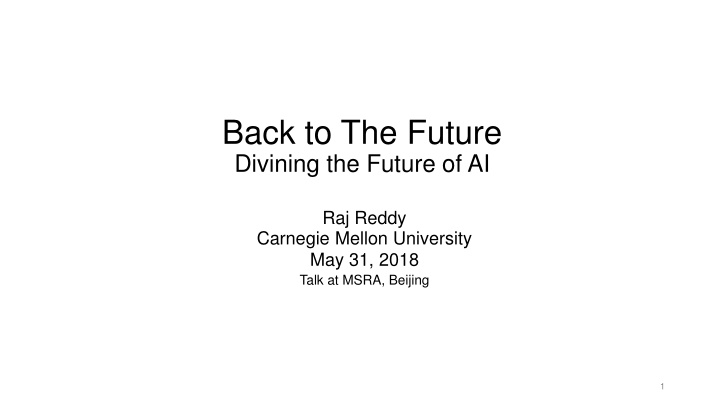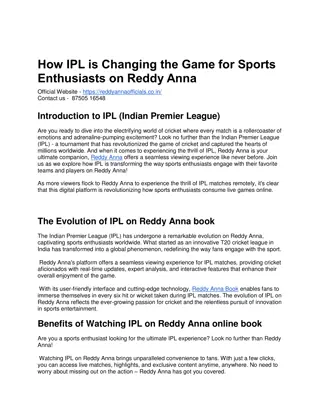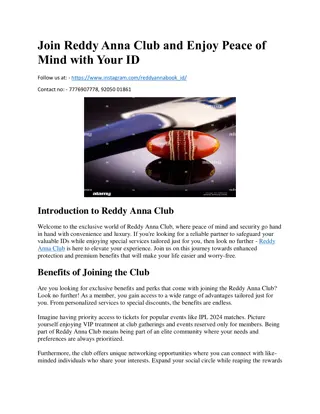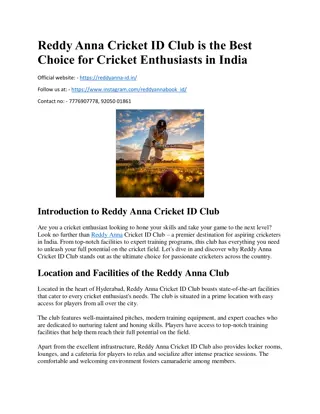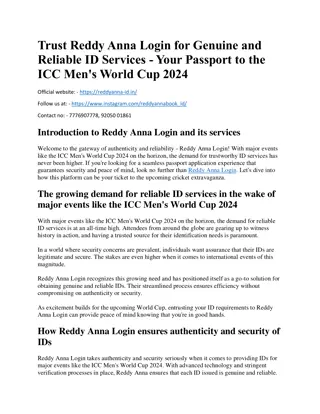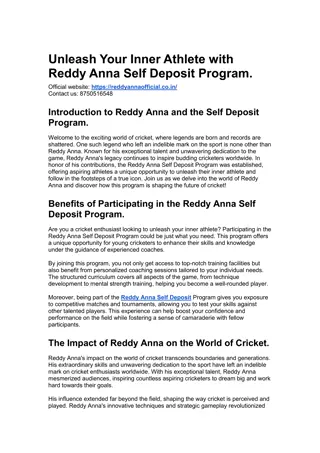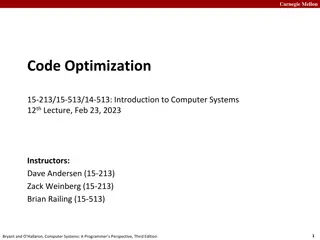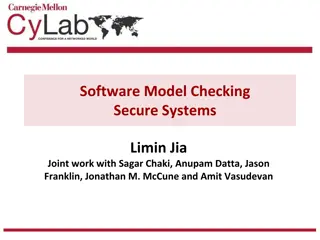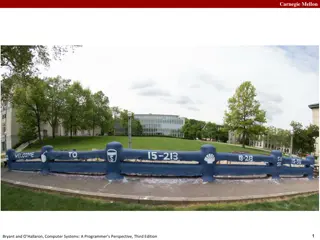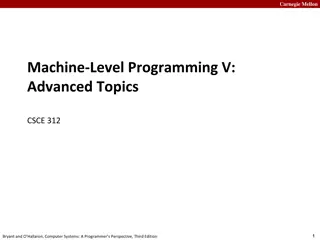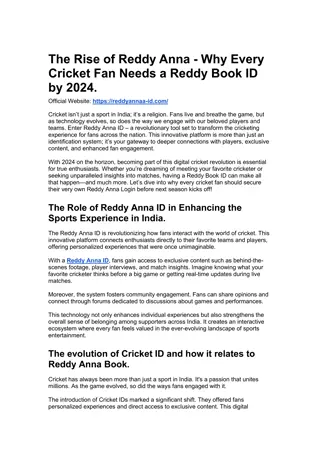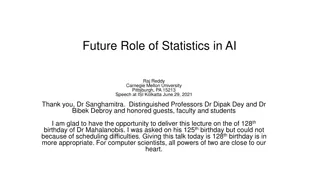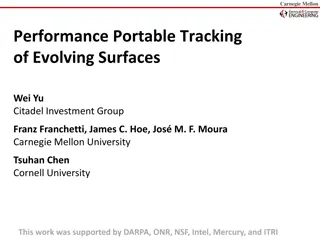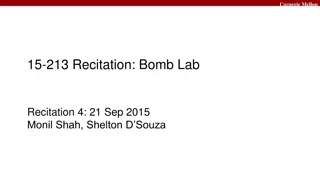Evolution of AI: Insights from Raj Reddy's Talk at Carnegie Mellon University
Delve into the future of AI through Raj Reddy's talk at Carnegie Mellon University, unraveling misconceptions, the essence of AI, historical context, and its progression into the 21st century. Explore themes such as human-AI symbiosis, problem-solving approaches, and the utilization of data-driven knowledge.
Download Presentation

Please find below an Image/Link to download the presentation.
The content on the website is provided AS IS for your information and personal use only. It may not be sold, licensed, or shared on other websites without obtaining consent from the author.If you encounter any issues during the download, it is possible that the publisher has removed the file from their server.
You are allowed to download the files provided on this website for personal or commercial use, subject to the condition that they are used lawfully. All files are the property of their respective owners.
The content on the website is provided AS IS for your information and personal use only. It may not be sold, licensed, or shared on other websites without obtaining consent from the author.
E N D
Presentation Transcript
Back to The Future Divining the Future of AI Raj Reddy Carnegie Mellon University May 31, 2018 Talk at MSRA, Beijing 1
AI Revisited: Misconceptions and Hype
What is AI? AI Does Not Attempt to Replace Humans Misconception leading to Many Outrageous Statements AI Will Kill Us All AI Will Enslave Us AGI and ASI: Stupid Terminology Singularity is a Myth The Role of Engineering is the Enhance the Physical Capabilities of Humans The Role of AI is to Enhance the Mental Capabilities of Humans Human Machine Symbiosis AI Can Solve Some Problems That Humans Cannot Big Data Driven Discoveries Humans Can Solve Some Problems That Machines Cannot Together They Can Solve Problems Faster Better and/or Cheaper
What is AI? AI is an attempt to automate tasks that are usually though to be uniquely Human Requiring Intelligence, Intuition, Creativity, Innovation, Emotion, Empathy Usually Human coding using Heuristics, Rules, and Statistical Models - HMMs Non Sequential Algorithms Early Attempts Attempts to Solve Problem not Expressible as Classical Algorithms Proving Theorems, Playing Chess Understand Language, Speech, Images Create Robots that Sense Think and Act Later Systems attempted Compose music, Painting Automate trading in Stock Market Usually leads to Imperfect Solutions OCR error rates 99% 2010 Flash Crash: Dow Lost 1000 points in 36 minutes
AI In 20th Century: Use of Knowledge in Problem Solving An Intelligent System must Learns from Experience Use Vast Amount of Knowledge Tolerate Error and Ambiguity Respond in Real Time Communicate with Humans using Natural Language Search Compensates for Lack of Knowledge Puzzles Knowledge Compensates for Lack of Search F=ma; E = mc2 Traditional Sources of Knowledge Formal Knowledge: Learnt in Schools and Universities Books, Manuals, Informal Knowledge: Heuristics from Peoples and Environment Human Encoding of Knowledge Expert Systems Knowledge Based System Rule Based Ssytem
AI in 21st Century: Discover and Use Data Driven Knowledge Sources Paradigm Shift in Science First 3 Paradigms: Experiment, Theory, Simulation Rutherford, Bohr, Oppenheimer 4th Paradigm: Data Driven Science Create Next Generation AI systems Data Driven AI systems To Solve Previously Unsolved Problems Previously Unavailable Sources of Data Knowledge from Big Data: Data Driven Learning of Models and Algorithms Knowledge from Multiple (Cross) Media: Social Media Intelligence Gathering From All Language Sources From All the Media: Text, Speech, Image and Video Knowledge from Crowd Intelligence: Global Brain: from Individual Intelligence to Collective Intelligence Knowledge from Augmented Intelligence: Human-Machine Hybrid Intelligence for Collaborative Problem Solving Knowledge from Unmanned Autonomous Vehicles: Intelligence from Collaborating Teams of Robots Automatic Discovery of New Knowledge Machine Learning using Big Data Deep Learning
1960s: The Golden Age of Stanford AI Lab Robotics Computer Vision Knowledge Engineering Speech Language Understanding Computer Music Chess, Symbolic Mathematics, Correctness of Programs, Theorem Proving, Logical AI, Common Sense Time Sharing LISP DEC Clones: Foonly, Graphical Editors, Pieces of Glass, Theory of Computation
The Hand Eye Project Interaction with the Physical World Early work by Karl Pingle, Bill Wichman, Don Pieper Main Project Team Jerry Feldman, R. Lou Paul, Marty Tenenbaum, Gerry Agin, Irwin Sobel, etc. Robotic Hands Bernie Roth and Vic Scheinman Started in 1965 Using the PDP1 and later the PDP6 Led to Machine Vision and Robotics Industry Via SRI and Vic Scheinman
Image Analysis and Understanding Image Analysis Manfred Hueckel, Ruzena Bajcsy, and Tom Binford Led to Vision and Robotics at UPenn Image Understanding Natural Scenes and Face Recognition Mike Kelly and Raj Reddy Led to Vision and Robotics at CMU
Mobile Robotics Mars Rover and Stanford Cart Marvin Minsky (visiting) Mars Explorer project 1964 Les Earnest Bruce Baumgart Lynn Quam Hans Moravec Rod Brooks (later in the seventies) Influenced direction of programs at CMU, MIT and SRI
Capturing Expertise Heuristic Dendral: Representation, acquisition and use of knowledge in chemical inference Project Team Ed Feigenbaum, Josh Lederberg, Bruce Buchanan, Georgia Sutherland et al. Started in 1965 Led to Expert Systems, Knowledge Engineering Knowledge Based Systems Industry Early Applications of AI
Speech Speech Input to Computers Started in 1964 as a class project Using a PDP1 with drum memory and a display By the end of 1964 we had a vowel recognizer running Project team in the sixties Raj Reddy, Pierre Vicens, Lee Erman, Gary Goodman, Richard Neely Led to the DARPA Speech Understanding Project during the years 1971-76 Led to CMU Advances in Speech and MSRA Kai-Fu Lee Hsiao-Wuen Hon Xuedong Huang Mei-Yuh Hwang Most influential branch of Speech Recognition Industry: Dragon Systems, Apple, Microsoft Indirectly IBM and Bell Labs
Language Understanding Parsing and Understanding of Natural Language: Question Asking and Dialog Modeling Computer Simulation of Belief systems Ken Colby, Lawrence Tesler, Horace Enea et al Parsing of Non-Grammatical Sentences Colby, Enea et al Conceptual Parsing Roger Shank Led to Language Processing Industry via Shank and associates Led to other Language Processing groups at Yale and UCLA CMU, UMass, Berkeley, etc. Influential strand of Language research
Computer Music Computer Synthesis of Music Started in 1964 on PDP1 John Chowning Leland Smith Andy Moorer Impact Led to Yamaha adopting digital synthesis for consumer products Establishment of a Center in Computer Music in Paris
Other AI Projects Chess and other game playing programs Kalah: R. Russell Chess: McCarthy, Barbara Huberman (Liskov) Checkers: Art Samuels Symbolic Mathematics Algebraic Simplification: Wooldridge and Enea Reduce: Tony Hearn Proving Correctness of Programs Correctness of Programs: McCarthy and Painter Equivalence of Programs: Kaplan and Ito Properties of Programs: Zohar Manna Theorem Proving David Luckham and John Allen Use of Predicate Calculus as a Representation for AI McCarthy, Cordell Green et al AI and Philosophy McCarthy and Pat Hayes Programs with Common Sense McCarthy, later by Doug Lenat
1970s: Knowledge Centric AI Understanding Speech in 70s Blackboard Model Hearsay Communicating and Collaborating Knowledge Sources Hypothesis and Verify paradigm of Knowledge Sharing At Stanford: Penny Nii and EAF Performance Matters: Compiling Knowledge Dragon System Compile Knowledge Sources into an integrated graph structure representation Harpy Graph optimization to eliminate redundant sub-graphs Beam Search prunes search to look at promising alternatives and eliminates backtracking 17
Sagan Report 1978 Machine Intelligence and Robotics in Space Role of MI and Robotics within NASA Space Exploration Space Exploitation Space Colonization Accidents Happen to Prepared Minds (Simon quoting Pasteur) Working on the Sagan report (as the vice-chair) prepared me for the recognizing the enormous problems of knowledge capture and use implied by the Songs of the Distant Earth 18
1980s: At the Robotics Institute at CMU Necessary Conditions for Self Reproducing Factories Self Reproducing Experiments at RI with Fritz Prinz (now at Stanford) on Self Reproducing Lathes in 1983-84 Self Repair Precision remote tele-operation: McCarthy s Proposal Self Diagnosis Self Awareness Self Operation Experiments in Mechanical MOSIS with Paul Wright (now at UC Berkeley) The 90% Solution 19
Arthur Clarke in 1985 The Songs of the Distant Earth Colonization of Earth-like Planets in other solar systems Capturing the Knowledge for the Mothership 3000AD + God-made knowledge Man-made knowledge Vedas, Tripetikas, Bible and Koran left behind! Actionable Knowledge Structured, Unstructured, Implicit Knowledge Can we do it? What would it take? What are the intermediate goals? 20
AI in the 80s: To be or Not to be Creation of AAAI Newell as President and Feigenbaum as President Elect Bruce Buchanan, Bob Balzer, Bob Englemore The Ascent and Decline of AI Industry EAF at the center Boom Times: AAAI in Philadelphia 6000+ people Attacks and Self doubt Change the Name? 21
Musings in the 1980s: What is AI anyway? Newell s criteria for an Integrated Intelligent System Learn from Experience Use Vast Amounts of Knowledge Exhibit Goal Directed Behavior Tolerate Error and Ambiguity Communicate using Language and Speech, and Operate in Real time Laws of AI Faced with Complexity, humans choose suboptimal solutions Humans don t give up claiming it is NP-Complete An Expert knows 50K +/- 20K Chunks of Knowledge A physical symbol system is necessary and sufficient for Intelligence Search Compensates for Lack of Knowledge When in doubt sprout! Knowledge circumvents the need for Search Knowledge reduces uncertainty eliminating trial and error behavior 22
1997 Deep Blue beats Kasparov The Grand Challenge Problems: Knowledge is Indispensable World Champion Chess Machine Read a book and answer questions at the end of chapter Observe and learn to assemble a Mars Rover or a bicycle .. 23
Village Google An AI-Centric and AI-Complete Problem Can an uneducated person benefit from the use of Information Technology? Can IT be affordable, accessible and available? 4Cs: Connectivity, Computing Platform, Capacity Building, and Content Access to Knowledge and Knowhow? The Village Google experiment with UN-FAO Question: Speech in local language Answer: Video answer from Expert in local language AI-Centric and AI-Complete 24
Major Breakthroughs in AI of the 20th Century Enabled by Brute-force, Heuristics, Human Coding of Rules and Knowledge, and Simple Machine Learning (Pattern Recognition) World Champion Chess Machine IBM Deep Blue Mathematical Discovery Proof Checkers Accident Avoiding Car CMU: No Hands Across America Robotics Manufacturing Automation Disaster Rescue Robots Speech Recognition Systems Dictation Machine Computer Vision and Image Processing Medical Image Processing Expert Systems Rule Based Systems Knowledge Based Systems
Major Breakthroughs in AI in 21st Century Enabled by Big Data and Machine Learning Language Translation Google Translate: Any Language to Any Language Speech to Speech Dialog Siri, Cortana, Alexa Autonomous Vehicles CMU, Stanford, Google, Tesla Deep Question Answering IBM s Watson RoboSoccer World Champion Poker CMU Libratus No Limit Texas Hold em Poker
The Next Millennium: Research Agenda for the Future of AI? Improve Human Productivity by 1000% 10 20 Years Grand Challenge Problems 20 50 Years Human Level AI 50 100 Years Super Human AI 100 1000 Years 27
Looking back: What we missed! Personal Computers! Alan Kay s dynabook vs Apple and PCs Internet and the WWW ARPAnet in 1968 with Stanford as one of the initial nodes Moore s Law and VLSI Graphics Human Computer Interaction UI design
Looking back: off in timing! Speech Vision Robotics Natural Language
Recent Trends in AI Learning Systems Learn from examples Learn from experience Dynamic Learning Learning from Sparse data Architecture of Intelligence Integrated Intelligence Learn from Experience Use Knowledge Communicate using Speech and Language Operate in real time etc
Recent Trends in CS Lisp Timesharing Algorithm Design Systems Graphics UI Hardware Functional Languages Thin Clients Scalable Dependable beyond OS 2D to 3D Illiterate users? Low power mobile
Whither AI? Arthur Clarke s The Songs of the Distant Earth Ray Kurzweil s Immortality
Whither CS? Computers are for Entertainment and Communication Not for Computing People are the Killer App from Parc Software as Service Death of Software Product Market Net 2.0 and Web Services Cell Phone as the Dominant Computing Platform Embedded Body Computers
In Conclusion Much of what transpired in AI and CS in the last 40 years can be seen to have roots in the activities of the 60s! Except that we now have a million times more computing power! AI Needs Robust CS Million times more processing Million times more Memory Million times more Bandwidth May be we do need 1.7 Einsteins, 3 Maxwells and 0.7 Manhattan project (McCarthy, 1980s) to get there
